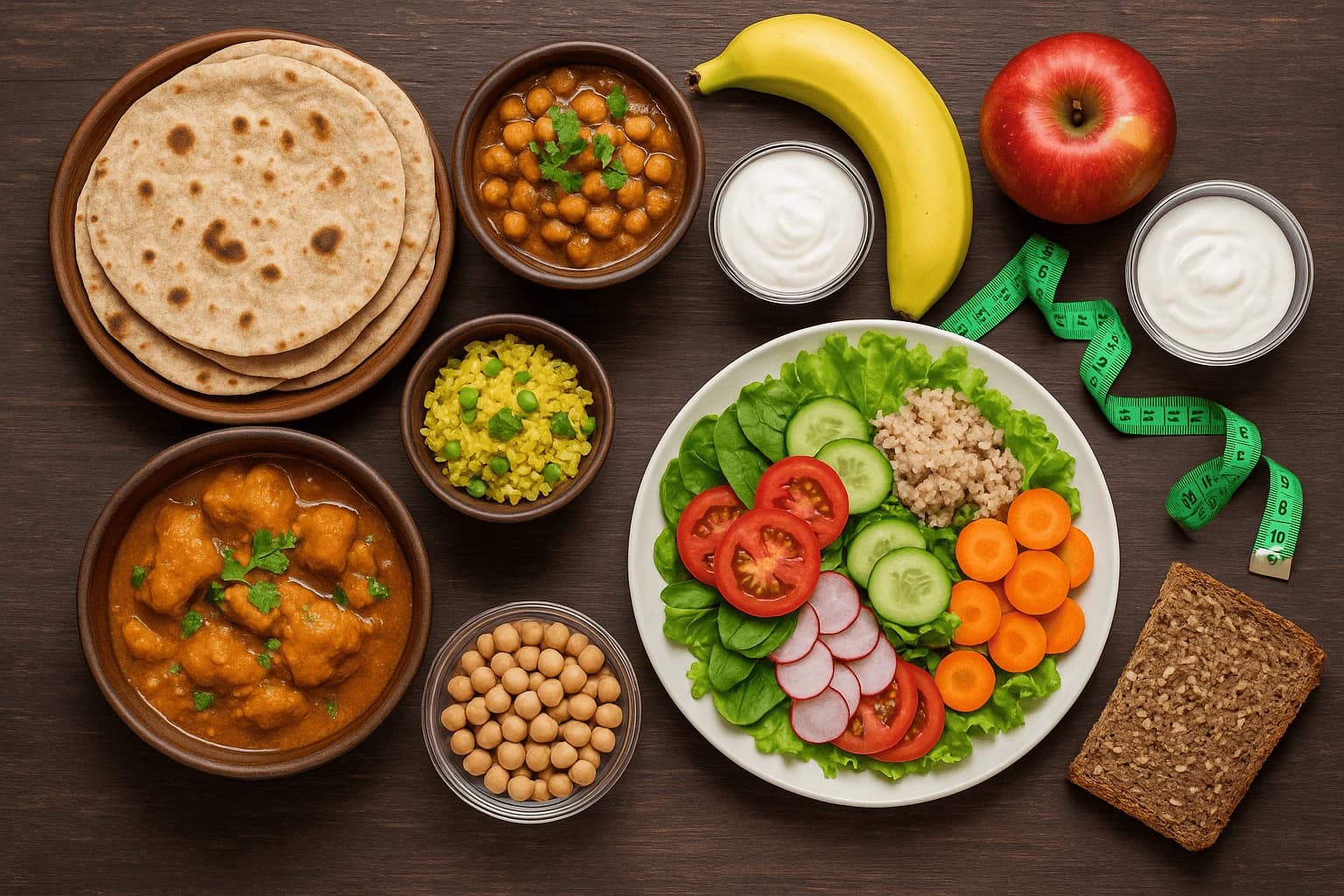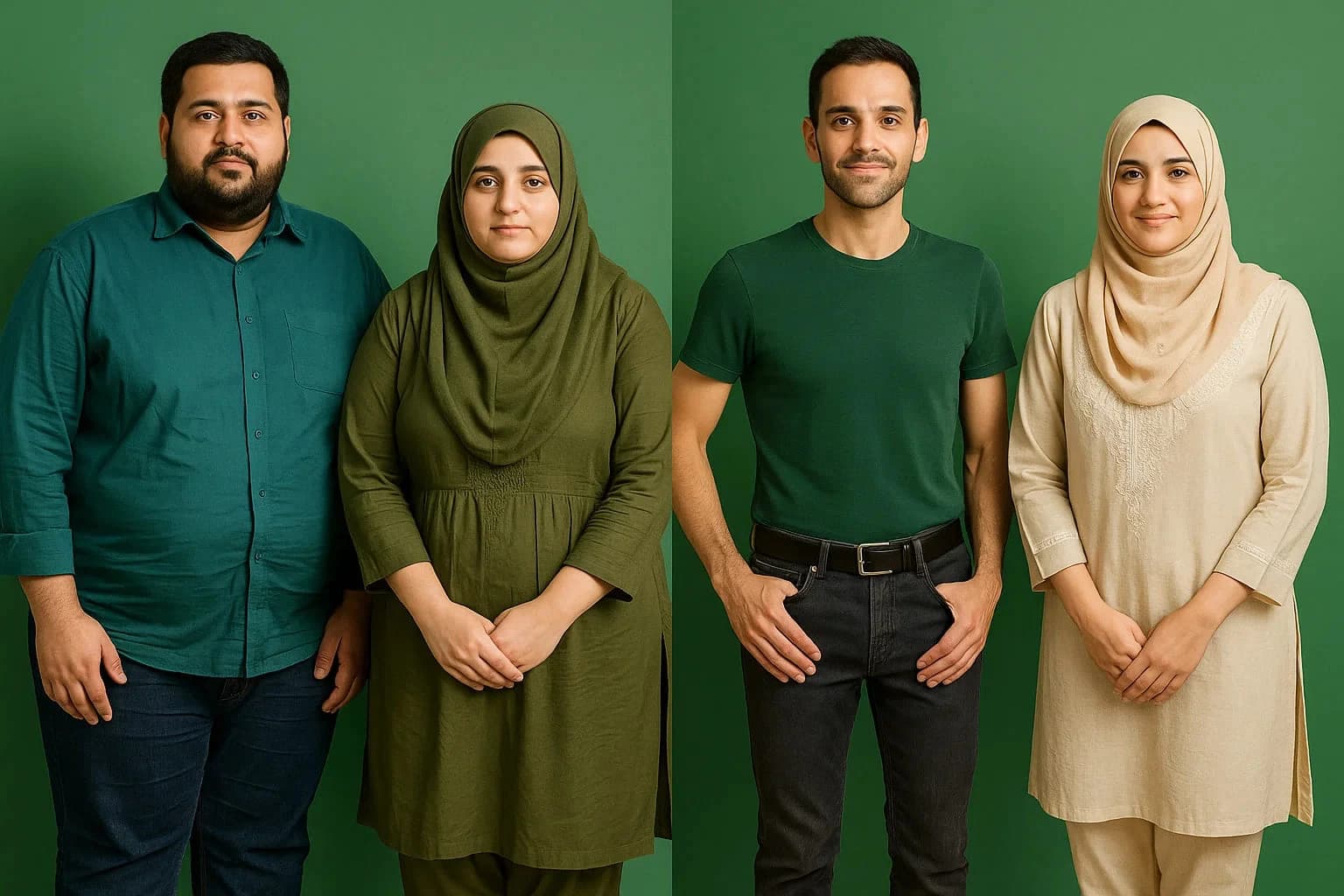© 2025 Roz UpdatesbyTETRA SEVEN

* All product/brand names, logos, and trademarks are property of their respective owners.
In recent years, the conversation around food in Pakistan has evolved far beyond taste and tradition. Today, it's also about health, awareness, and lifestyle. As people become more health-conscious, the choices they make about what lands on their plate are shifting rapidly. With increasing access to global information and a boom in social media influence, Pakistanis are now exploring new diet trends — while still holding onto the comfort and richness of their traditional meals.
For decades, the Pakistani diet has revolved around wheat-based breads like chapati and naan, lentils, vegetables, spices, and a hearty portion of meat — all cooked with love (and often, a generous dose of oil). Meals are deeply rooted in cultural practices and are often shared as family rituals. But as urbanization accelerates and life becomes faster-paced, especially in big cities like Karachi, Lahore, and Islamabad, more people are moving toward convenience-driven, modern food options.
Diet plans like keto, intermittent fasting, veganism, and high-protein regimens are becoming more common, especially among the urban youth. Influencers and celebrities promote smoothies, supplements, and salad bowls as “health hacks,” while dieticians warn against fad diets that lack balance. Amidst all this, the challenge is clear — how do we balance the richness of our traditional Pakistani diet with the demands of modern nutrition science?
This blog will explore that exact intersection. We’ll take a closer look at how traditional dietary practices in Pakistan offer both nutritional strength and potential health risks. We'll also dive into modern diet trends that are rising in popularity and analyze whether they’re a good fit for the local context. Most importantly, we’ll talk about how Pakistan can find a sustainable middle ground — one that honors culture while promoting better health outcomes.
For generations, Pakistani households have followed age-old dietary patterns passed down through families and deeply rooted in regional customs. These eating habits are built around natural, locally available ingredients and time-tested recipes that serve both taste and nourishment. Unlike the processed foods and quick meals of today’s modern lifestyles, traditional Pakistani meals are often slow-cooked, rich in flavor, and made with a variety of fresh vegetables, grains, spices, and proteins. While these customs offer many nutritional benefits, they are also evolving to meet the demands of a changing society. Let’s explore the components, health benefits, and cultural significance of these traditional diets that continue to shape how millions of Pakistanis eat every day.
Pakistan is a land of rich culinary diversity, and its traditional diet reflects that vibrancy. The staples of a traditional Pakistani meal include roti or chapati made from whole wheat, rice, lentils (daal), seasonal vegetables, and meats like chicken, beef, and mutton. These dishes are often accompanied by yogurt, pickles (achar), and a glass of lassi or tea.
Regional variation plays a significant role in shaping dietary habits. In Punjab, people enjoy rich, buttery parathas and lentil-based dishes like chana daal. Sindh leans more towards spicy curries, fish, and rice dishes like Sindhi biryani. In Khyber Pakhtunkhwa (KPK), the focus is more on grilled meats, dry fruits, and bread like naan. Balochistan is known for its slow-cooked dishes like sajji, made with lamb or chicken. Each region brings its own flair to the traditional Pakistani diet, offering a diverse range of flavors and nutrition profiles.
Traditional Pakistani food, when cooked with balanced ingredients and minimal oil, can actually be very nutritious. Whole grains like wheat provide fiber and energy, lentils are excellent sources of protein, and seasonal vegetables offer essential vitamins and minerals. Spices like turmeric, ginger, and cumin have anti-inflammatory and digestive properties. Yogurt supports gut health, while nuts and seeds used in various dishes contribute healthy fats and protein.
Many of these ingredients can be considered “Pakistani superfoods” due to their high nutritional value. For example, saag (leafy greens) is rich in iron and calcium, and dishes like khichdi (a mixture of rice and lentils) are easy to digest and nutrient-dense.
Food in Pakistan is more than just sustenance — it's a social and spiritual experience. Islamic dietary laws (halal) dictate how food is prepared and consumed, and religious events like Ramadan significantly impact eating habits. During Ramadan, meals like sehri and iftar emphasize energy-boosting, hydrating, and wholesome foods.
Culturally, meals are often shared with extended family, and hospitality is deeply rooted in serving generous portions to guests. While this promotes bonding, it can also lead to overconsumption if portion control isn't observed — especially when deep-fried items and rich desserts are involved.
In summary, the traditional Pakistani diet, with its wide array of ingredients and deep cultural roots, offers both nourishment and identity. However, the shift toward more health-conscious choices calls for a re-examination of how we can preserve tradition while promoting well-being.
As Pakistan’s cities grow and lifestyles modernize, there’s a visible transformation in the way people eat — especially among younger, urban populations. While traditional meals still hold a special place in many households, there's a rising shift toward newer dietary habits influenced by global trends, social media, and the increasing awareness of personal health and wellness.
From calorie counting apps to meal-prep services, food choices are no longer just about what tastes good — they’re about energy, weight control, and long-term health goals. Urban Pakistanis, particularly in cities like Lahore, Islamabad, and Karachi, are rapidly adopting dietary routines that once felt foreign just a decade ago.
Platforms like Instagram, YouTube, and TikTok have become powerful drivers of food culture in Pakistan. Influencers, fitness trainers, and vloggers regularly share diet plans, healthy recipes, and workout meals, shaping how people think about food. Buzzwords like “clean eating,” “superfoods,” and “gut health” have entered mainstream conversations, especially among younger generations.
Globalization has also expanded access to a wider variety of foods. Supermarkets now carry almond milk, quinoa, and granola bars — once rare items — catering to a health-focused audience. This exposure is encouraging people to rethink their daily meals and adopt healthier, more controlled eating habits.
Among the most popular modern diet trends in Pakistan are the ketogenic (keto) diet, intermittent fasting, and plant-based eating. The keto diet, with its low-carb, high-fat principles, has gained traction with those looking for quick weight loss. Intermittent fasting, particularly the 16:8 method (16 hours fasting, 8 hours eating), is popular among working professionals who want a simple, structured plan.
Plant-based diets are also making their way into the Pakistani mainstream, not just for ethical reasons but also due to health concerns like cholesterol and diabetes. While full veganism is still rare, many people are choosing to reduce their meat and dairy intake in favor of vegetables, legumes, and non-dairy alternatives.
Interestingly, two contrasting trends are growing simultaneously: one toward organic and whole foods, and another toward processed and convenience-driven options. On one end, wellness stores and farmers’ markets are thriving, offering organic fruits, gluten-free grains, and sugar-free snacks. On the other, food delivery apps are booming, offering fast food, frozen meals, and sugar-heavy beverages at the tap of a button.
This contrast highlights the challenge of navigating health in a convenience-first culture. While access to health-conscious options is increasing, so is the temptation to choose ultra-processed alternatives for the sake of ease.
In summary, modern dietary trends in Pakistan reflect a complex blend of health consciousness, global influence, and convenience. As more people seek balance in their lives, the food they eat is becoming a reflection of both personal values and modern pressures.
As Pakistan navigates the dietary crossroads between traditional meals and modern nutrition trends, the country is also facing a growing health crisis. Obesity rates are climbing, diabetes is becoming alarmingly common, and malnutrition remains a concern — particularly among children and women. The conflict between age-old eating habits and new-age diets raises a critical question: are we getting healthier, or just more confused?
Both traditional and modern diets offer their own set of benefits and risks, but when adopted without understanding, they can contribute to serious health consequences. Finding the right balance is essential for building a sustainable and nourishing food culture.
In recent years, Pakistan has seen a spike in non-communicable diseases like type 2 diabetes, hypertension, and obesity — especially in urban areas. Sedentary lifestyles combined with high-calorie diets are major contributors. Children and teenagers are consuming more fast food, sugary beverages, and processed snacks, while physical activity continues to decline.
On the flip side, malnutrition and micronutrient deficiencies still plague rural and low-income communities. Many families lack access to a variety of foods rich in iron, calcium, and vitamins, leading to stunted growth and weakened immune systems. This double burden — overnutrition in cities and undernutrition in villages — shows how unequal the food system can be.
While modern diets are often promoted as “healthier,” they’re not without flaws. Many people jump into trendy regimens like keto or intermittent fasting without proper guidance, leading to fatigue, nutrient deficiencies, and hormonal imbalances. High reliance on supplements and processed “health” foods also creates a false sense of well-being.
Moreover, extreme dieting and body image pressure fueled by social media can encourage disordered eating patterns. Skipping meals, yo-yo dieting, and obsessing over macros may backfire and result in poor mental and physical health outcomes.
Rather than choosing between tradition and modernity, a better approach may be to blend the two. Traditional Pakistani foods can be made healthier by adjusting cooking methods — for example, using less oil, incorporating more vegetables, or switching to whole grain flours. Modern dietary principles like portion control, mindful eating, and balanced macronutrient intake can complement these traditional habits.
This fusion mindset respects cultural roots while embracing the science of nutrition. It allows families to enjoy their favorite meals without compromising on health, and it encourages people to eat in a way that supports both heritage and well-being.
In essence, the key to a healthier Pakistan lies not in abandoning tradition or blindly following trends, but in building a balanced relationship with food — one that honors the past while planning for a healthier future.
Despite increasing discussions about health and food in Pakistan, nutrition education still lags behind. Many people, particularly in rural areas, lack basic knowledge about balanced diets, portion control, or the long-term effects of unhealthy eating. While urban populations have more access to information, that doesn’t always translate to better choices — often, it's confusion over conflicting diet trends. In both cases, there's a clear need for practical, culturally relevant nutrition education that empowers people to make informed food decisions.
This section explores the barriers and breakthroughs in improving nutritional awareness and access across the country.
In urban centers, there's a growing interest in healthy eating, driven by digital media, education, and a wider range of food options. However, even in cities, many people rely on misinformation from unqualified influencers or “fad” diets that don’t suit their body or lifestyle. Nutrition awareness exists — but it’s often inconsistent or based on myths.
In contrast, rural populations face more structural challenges. Lack of formal education, limited access to diverse foods, and deep-rooted traditional beliefs often prevent the adoption of healthier practices. For example, some rural diets lack protein variety or essential vitamins, while others depend heavily on starchy foods. There's also minimal exposure to educational campaigns or public health messages.
Fortunately, some progress is being made through initiatives by the Pakistani government and NGOs. Campaigns under the National Nutrition Program aim to reduce malnutrition, especially among children and women. Organizations like UNICEF and the World Food Programme are working on school meal programs and micronutrient supplementation projects.
However, the scale of impact is still limited, and these programs often don’t address urban health risks like obesity or diabetes. There's a need for wider, more inclusive awareness campaigns that target both extremes — undernutrition and overnutrition — using schools, mosques, hospitals, and digital platforms as vehicles for education.
Even when people know what a healthy diet looks like, they don’t always have access to it. High inflation, poverty, and inconsistent food supply chains make it difficult for low-income families to afford fresh fruits, vegetables, and protein-rich foods. Many resort to cheaper, high-calorie foods that are filling but nutritionally poor.
On the sustainability front, Pakistan is also facing challenges related to water shortages, climate change, and food wastage. Promoting local, seasonal, and climate-friendly diets can help address both health and environmental concerns — but this requires systemic support and long-term planning.
To build a healthier nation, Pakistan needs to prioritize nutrition education as a public health essential — not just for schools and hospitals, but for communities, businesses, and policy makers alike.
As Pakistan strides forward in a rapidly changing world, our food choices have become a powerful reflection of that journey. On one side, we have the time-honored tradition of homemade meals filled with flavor, cultural depth, and natural ingredients. On the other, a modern wave of diets and nutritional advice is sweeping through urban centers, offering new solutions for old health problems. Both paths have their own value — but it’s the intersection of the two that offers the greatest promise.
A balanced diet in Pakistan doesn’t mean giving up nihari or avoiding biryani forever. It means learning how to enjoy these traditional dishes in moderation, paired with the knowledge and tools of modern nutrition. It's about cooking with less oil, incorporating more greens, drinking water instead of sugary sodas, and understanding that “healthy” isn’t a trend — it’s a long-term commitment to well-being.
For this to truly work, both individuals and institutions need to play a part. Families can start by being more mindful about portion sizes and ingredients. Schools should teach kids the basics of healthy eating early on. Health professionals must guide people with culturally relevant nutrition advice. And the government, alongside NGOs, must ensure access to affordable, diverse, and safe food for every Pakistani — rural or urban, rich or poor.
The future of food in Pakistan lies in finding this balance — embracing the strengths of traditional diets while adapting to the realities of modern life. It’s time to celebrate our food heritage, learn from global science, and most importantly, eat in a way that supports our health, environment, and identity.
So, whether you're preparing daal chawal or trying out quinoa salad — do it with awareness, intention, and pride.

9 October 2025

23 September 2025
No comments yet. Be the first to comment!